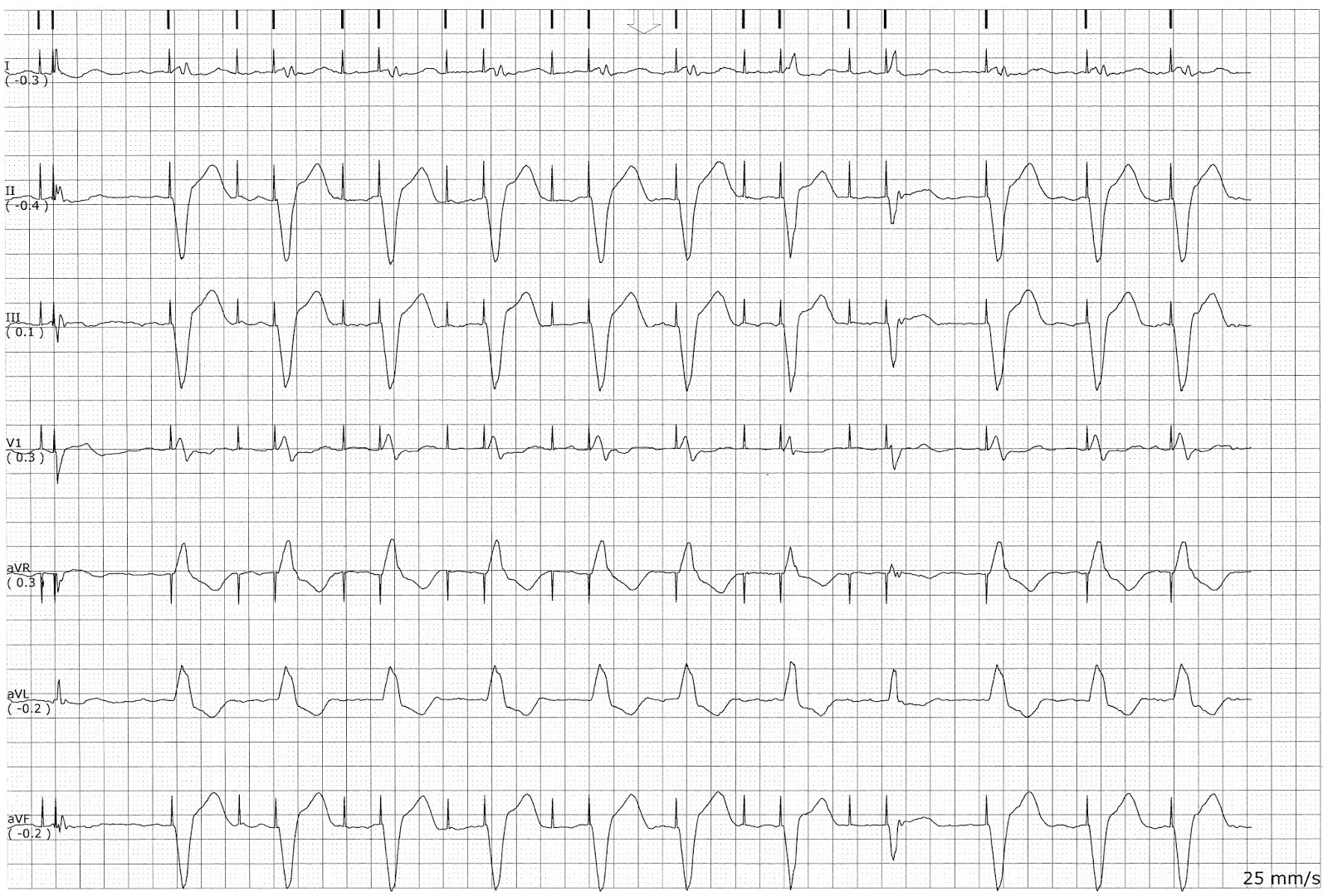
These are beats in which the pacer captured. The Light Blue Arrows point to pacing spikes that are followed immediately by wide beats (see brown arrows) that are typical of paced beats and different from the escape beats. It is not capturing and not resulting in a QRS. Therefore, it is just a coincidence that it happened at the same time as the onset of the QRS. The Dark Blue Arrow points to a pacing spike that occurs directly at the onset of a QRS, but that QRS looks exactly like those of the escape beat. The T-wave of the third escape beat is larger than the others because of a coincidentally superimposed P-wave. Red arrows show escape beats at regular intervals, which in lead II (across the bottom) appear narrow, but if you look up at the leads above, especially at V1 above the 3rd escape beat, you see that it is RBBB morphology and therefore is an escape from the left ventricle (an escape from the junction or bundle of His, along with RBBB, would have the same morphology but at a faster rate).Ī couple of these complexes are distorted by coincidental P-waves This latter one is the more likely explanation: that is to say that hidden pacing spikes due to absence of sensing is more likely than sensing + inhibition of pacing.)

If the spikes are there and just hidden, then the pacer is also not sensing : the escape QRS should inhibit pacing if that beat is sensed. This would be unusual, as when the pacer lead is able to sense it is also usually able to pace. If the spikes did not happen at all, that would be a result of the pacer sensing the QRS, resulting in inhibition of pacing. They may be there and hard to see (hidden) alternatively, they are not there at all.

There are 2 pacer spikes which are missing (between 3rd and 4th arrows and between 6th and 7th). However, the pacer is clearly not capturing the ventricle (not resulting in depolarization of myocardium, so no QRS). The fact that the sinus node is tachycardic tells us that the sinus node is probably "trying" (teleologically speaking) to compensate for inadequate cardiac output. They are not conducting at all (complete AV block) and thus are not affecting the ventricles at all. There may also be failure to sense, but it is not having any effect.īlack arrows show P-waves marching out regularly at a rate greater than 100. So what is happening here? Failure to capture. Try to figure it out before reading the explanation below. External pacing was attempted but not tolerated and, because the patient was only mildly hypoperfused, she was transported to the ED without further intervention.Įxam revealed a fresh surgical scar at the area of pacemaker placement with significant swelling due to hematoma at the site of insertion. Her prehospital ECG showed failure to pace by the internal pacer. She had recently had a DDD pacemaker placed. We place the magnet because a failure to pace may be due to oversensing (not undersensing) with inappropriate inhibition of pacing. The magnet turns off the sensing function and the pacer becomes "asynchronous," meaning it will fire at a regular rate regardless of the intrinsic activity of the heart.

This is why we use a magnet when there is failure to pace! To stop oversensing and thus stop inhibtion of pacing. In fact, when a pacemaker fails to generate an impulse (fails to pace), one reason may be oversensing, not undersensing. (If a heart beat comes soon enough, the pacer should sense it and inhibit pacing so that there is no pacing when it's not needed.) Failure to sense results in inappropriate pacing: when the pacer is not sensing intrinsic activity that is present (failure to sense), it fails to have its pacing appropriately inhibited. However, failure to sense is NOT a reason for absence of pacing. This made me realize that pacemaker function is not as well understood as I thought. One of the reasons I'm presenting this case is that several residents misunderstood the concept of "failure to sense," believing it to be a cause of absence of pacing. Either or both functions can be inhibited if the atrium or ventricle (or both) fires before the interval passes. So a DDD pacer can pace the atrium (if needed), then wait a defined period (e.g., 200 ms, like a PR interval) and pace the ventricle (if needed).


 0 kommentar(er)
0 kommentar(er)
